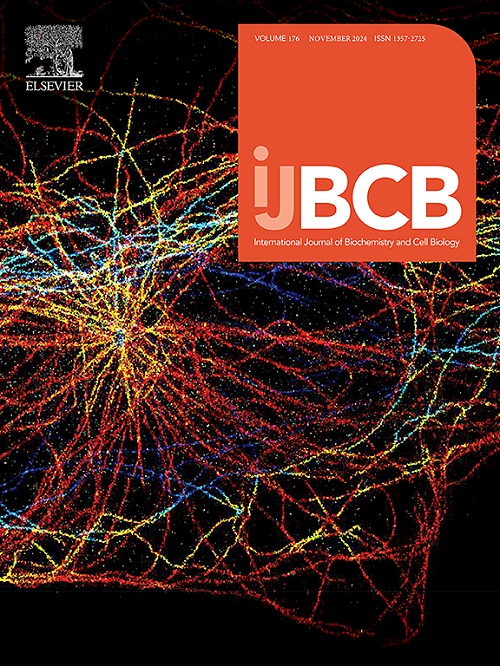Metabolic perturbations associated with hIAPP-induced insulin resistance in skeletal muscles: Implications to the development of type 2 diabetes
IF 3.4
3区 生物学
Q2 BIOCHEMISTRY & MOLECULAR BIOLOGY
International Journal of Biochemistry & Cell Biology
Pub Date : 2024-09-24
DOI:10.1016/j.biocel.2024.106665
引用次数: 0
Abstract
The human islet amyloid polypeptide (hIAPP) tends to misfold and self-assemble to form amyloid fibrils, which has been associated with the loss of function and viability of pancreatic β-cells in type 2 diabetes mellitus (T2DM). The role of hIAPP in the development of insulin resistance (a hallmark of T2DM) in skeletal muscles – the major sites for glucose utilization – needs further investigation. Even though, insulin-resistant conditions have been known to stimulate hIAPP aggregation, the events that lead to the development of insulin resistance due to hIAPP aggregation in skeletal muscles remain unidentified. Here, we have attempted to identify metabolic perturbations in L6 myotubes that were exposed to increasing concentrations of recombinant hIAPP for different time durations. It was observed that hIAPP exposure was associated with increased mitochondrial and cellular ROS levels, loss in mitochondrial membrane potential and viability of the myotubes. Metabolomic investigations of hIAPP-treated myotubes revealed significant perturbations in o-phosphocholine, sn-glycero-3-phosphocholine and dimethylamine levels (p < 0.05). Therefore, we anticipate that defects in glycerophospholipid metabolism and the associated oxidative stress and membrane damage may play key roles in the development of insulin resistance due to protein misfolding in skeletal muscles. In summary, the perturbed metabolites and their pathways have not only the potential to be used as early biomarkers to predict the onset of insulin resistance and T2DM but also as therapeutic targets for the effective management of the same.
代谢紊乱与 hIAPP 诱导的骨骼肌胰岛素抵抗有关:对 2 型糖尿病发展的影响。
人胰岛淀粉样多肽(hIAPP)倾向于错误折叠和自我组装形成淀粉样纤维,这与 2 型糖尿病(T2DM)患者胰岛β细胞功能和存活能力的丧失有关。hIAPP 在骨骼肌--葡萄糖利用的主要场所--胰岛素抵抗(T2DM 的标志)的发展过程中所起的作用需要进一步研究。尽管已知胰岛素抵抗条件会刺激 hIAPP 的聚集,但由于骨骼肌中 hIAPP 的聚集而导致胰岛素抵抗发展的事件仍未确定。在此,我们试图确定在不同时间段内暴露于浓度不断增加的重组 hIAPP 的 L6 肌管中的代谢扰动。据观察,暴露于 hIAPP 与线粒体和细胞 ROS 水平升高、线粒体膜电位下降和肌细胞活力丧失有关。对经 hIAPP 处理的肌管进行的代谢组学研究发现,邻磷酸胆碱、sn-甘油-3-磷酸胆碱和二甲胺水平发生了显著变化(p < 0.05)。因此,我们预计甘油磷脂代谢缺陷以及与之相关的氧化应激和膜损伤可能在骨骼肌蛋白质错误折叠导致的胰岛素抵抗发展过程中发挥关键作用。总之,受干扰的代谢物及其通路不仅有可能被用作预测胰岛素抵抗和 T2DM 发病的早期生物标志物,也有可能被用作有效控制 T2DM 的治疗目标。
本文章由计算机程序翻译,如有差异,请以英文原文为准。
求助全文
约1分钟内获得全文
求助全文
来源期刊
CiteScore
8.10
自引率
0.00%
发文量
124
审稿时长
19 days
期刊介绍:
IJBCB publishes original research articles, invited reviews and in-focus articles in all areas of cell and molecular biology and biomedical research.
Topics of interest include, but are not limited to:
-Mechanistic studies of cells, cell organelles, sub-cellular molecular pathways and metabolism
-Novel insights into disease pathogenesis
-Nanotechnology with implication to biological and medical processes
-Genomics and bioinformatics

 求助内容:
求助内容: 应助结果提醒方式:
应助结果提醒方式:


